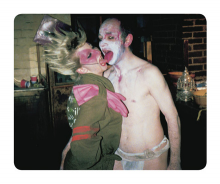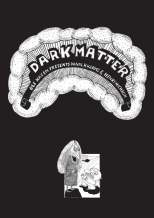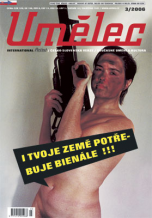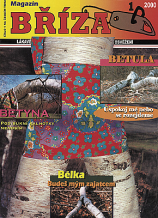| Umělec magazine 2007/2 >> Strange New World is coming to a future near you | List of all editions. | ||||||||||||
|
|||||||||||||
Strange New World is coming to a future near youUmělec magazine 2007/201.02.2007 Tony Ozuna | the border | en cs de es |
|||||||||||||
|
“The United States shares with Mexico a two-thousand-mile connection—the skin of two heads. Everything that America wants to believe about himself—that he is innocent, that he is colorless, odorless, solitary, self-sufficient—is corrected, weighed upon, glossed by Mexico, the maternity of Mexico, the envy of Mexico, the grievance of Mexico.”
Richard Rodriguez, Days of Obligation - An Argument with My Mexican Father Tijuana is both a city on the edge and in the middle. It is on the edge of Mexico and southern California, and in the middle—caught in the crossfire of migrants and police and border guards, smugglers going north and “escapees” from the system going south. However, in all the excitement along the border, Tijuana is also a city trying out a new identity, mostly due to the rise of its artistic and musical community gaining international attention over the past few years. Led by the upbeat-electronic music project, Nortec Collective, who has provided a regionally unique soundtrack to the border city, artists and musicians are supporting a negation of Tijuana’s images of violence, and instead have embraced their city’s unique history as a poor neighbor dependant, on its economic ties to San Diego and the North. It is a city that is on the fringe of Mexico, and has been practically independent for most of its history; and it is its combined third-world poverty, ugliness and connected to this, a special beauty of the city, which the Nortec generation appreciates; in essence, it is an embracing of its surrealistic reality. The Strange New World exhibit of art and design from Tijuana at the Santa Monica Museum of Art (2007) was the last stop and a scaled down version of a grander project organized and exhibited in 2006 at the Museum of Contemporary Art, San Diego, with an opening version at the Cultural Institute of Mexico in Washington D.C., also in 2006. At the Santa Monica version of Strange New World, the first room shows a video projection of streets from Tijuana, Los Angeles and San Francisco with high-tech computer images overlaid of Mexican push-cart vendors. “Informal Economy Venders” by Julio César Morales, is most interesting because the vendors’ carts are assembled on the spot, from computer-graphic floating parts in the air onto the city sites—appropriate as the colorful and noisy Mexican push-cart street vendors (selling tacos, tamales, ice cream and fruits and vegetables) have become common throughout California. Around the corner, Salvador Ricalde (1975) gets to the heart of the culture, with “Tecalas and tarolas” (Keyboards and drums) the invigorating Norteno sound on video clips (though heard only through headphones, and not loud enough even then). Ricalde’s spliced clips of banda music and dancehall images, combined with an orientation video of two Japanese managers giving advice to Mexicans on how to be productive workers for maquiladoras, should have been projected on a wall. Instead, nearby there is a silent but deadly sculptural-installation of the United States that covers a wall and ceiling overhead. It is a big America with a vagina in the center. The vagina is at the same time a Virgin Mary, but hardly a holy image. The vagina is ringed or webbed with limbs linking to all ends of the nation like a serpent. The horizontal limbs, filled with gold, end as multi-headed snake heads, while the circular limbs that interconnect with the gold limbs, are filled with pinto beans. The beans represent the Mexican workers as an irreplaceable link to the economic chain of the United States, the workers feeding and sustaining the Beast. This expansive piece by Einar & Jamex de la Torre, (1963, 1960) titled “Exporting Democracy,” also includes silver airplanes overhead or rather they are figures of Jesus crucified on the cross (that resemble airplanes) seemingly on suicide or liberation missions, flying down into bombing targets in the Middle East and Africa. At least Tijuana is safe from this wrath of El Gringo. Nevertheless, the border is also a battle zone with the States, and the works by Marcos Ramírez aka ERRE underline this tension. ERRE’s public art efforts are best known through inSITE, where in 1994 he erected a huge Trojan horse and joined it in the long line of traffic waiting to cross the border into the USA. The two-headed horse looked in both directions, which confused people about who was even invading whom, and this horse quickly became a visual symbol of the rising verve of the city’s artistic community. For Strange New World, ERRE (1961) collaborated with Los Angeles author and social historian, Mike Davis (“City of Quartz” “Ecology of Fear” and most recently, “No One Is Illegal: Fighting Racism and State Violence on the U.S.-Mexico Border”) to create a full-sized, professional-looking billboard placed on a major highway (Interstate 5) between San Diego and the border, as well as a scaled-down version for galleries. The Prejudice Project has text across the top, “Don’t Be A Man For Just A Minute. Be A Man Your Whole Life,” (written by Davis) and aimed at the Minutemen, the controversial group of “patriotic” armed volunteers who have begun guarding the US border against illegal immigration. The text is written in the font and style of American Army recruitment posters, which proclaim “Be All You Can Be—In The Army.” Below the text there is a panoramic view of the border from the US side, and the head (backside view) of a man in a military camoflauge t-shirt looking toward Tijuana. Besides providing the text, Davis also provides the head (more like red-neck and grey hair) for the billboard. Less political works are also noteworthy in this exhibition. René Peralta’s huge wooden cubes intersect the space almost to the high ceiling. They are laser-cut fine wood panels designed to resemble the typical wrought-iron gates and window bars found throughout Mexican neighborhoods, serving both a protective and decorative purpose. Peralta’s “contain(mex) 3 = contiene(mex) 3” was done in collaboration with his architectural firm generica. There is a simple elegance (and lightness) to this structure by Peralta (1968), that bisects the gallery space, even offering a psychological relief from the heavier content of the socio-political pieces, which tended to be more on one side than the other. Amidst all this, Jaime Ruiz Otis (1976) transforms discarded materials from maquiladoras, the industrial import-export mass-assembly factories that have lined up along the border, on the Mexican side, after NAFTA. These mostly synthetic plastics are used to form sculptures or installation, and in this exhibit he has used trash from the factory dumpsters to create an oversize machine gun, which hangs on the wall, made of plastic scraps, laden with seemingly hundreds of children’s plastic bullets and small pistols. He also created a series of engravings from printing plates, polyurethane mats which were originally used as cutting boards for fabrics, metal and plastics. These used surfaces, which were repeatedly stamped, marked, cut, create a grim, industrial art gesture once transferred onto their inked imprints on paper. Alida Cervantes (1972) is one of the few artists in this exhibit born on the other side of the border, in San Diego and was raised in affluent southern California suburbia, though she currently lives partly in Tijuana. Her recent “Housekeeping Series” is a group of portraits of Mexican women who have been illegal housekeepers (the multi-purpose term for cleaning ladies, maids, cooks, etc. all in one) for her family circle. The portraits are done in a realistic style and effectively personalize still a largely invisible social (working) class in the United States. Cervantes’s portraits show real people who are mainly stereotypes or simply not shown at all in media, because there is nothing especially controversial or sexy about them. However, there is a simple dignity to all of them that Cervantes reveals or doesn’t lose in the process of painting them, and thus, this is a sincere gesture of respect for the other side, el otro lado, which is generally absent in American society. Through the exhibition Strange New World, the other side has been given a good chance to show its new identity—a face that is partly a fearless and provocative one, but also one steeped in social awareness, involving functional (and practical) progressive architecture and design, and as a collective effort, Tijuana is now comfortable enough to make its point without the need to constantly shock and upset the public, as some border-artists have done in the past. Almost fifty artists and various art, design, and architectural collectives from Tijuana have effectively pulled off their Mexican masks, revealing a community that is sharing a joy of life and earnestness to alter their own situation through art, since everything else of promise from governments to their North and South has ultimately failed to be to their communities’ benefit, throughout its unique history.
01.02.2007
Recommended articles
|
|||||||||||||
|
04.02.2020 10:17
Letošní 50. ročník Art Basel přilákal celkem 93 000 návštěvníků a sběratelů z 80 zemí světa. 290 prémiových galerií představilo umělecká díla od počátku 20. století až po současnost. Hlavní sektor přehlídky, tradičně v prvním patře výstavního prostoru, představil 232 předních galerií z celého světa nabízející umění nejvyšší kvality. Veletrh ukázal vzestupný trend prodeje prostřednictvím galerií jak soukromým sbírkám, tak i institucím. Kromě hlavního veletrhu stály za návštěvu i ty přidružené: Volta, Liste a Photo Basel, k tomu doprovodné programy a výstavy v místních institucích, které kvalitou daleko přesahují hranice města tj. Kunsthalle Basel, Kunstmuseum, Tinguely muzeum nebo Fondation Beyeler.
|





































 We Are Rising National Gallery For You! Go to Kyjov by Krásná Lípa no.37.
We Are Rising National Gallery For You! Go to Kyjov by Krásná Lípa no.37.
Comments
There are currently no comments.Add new comment